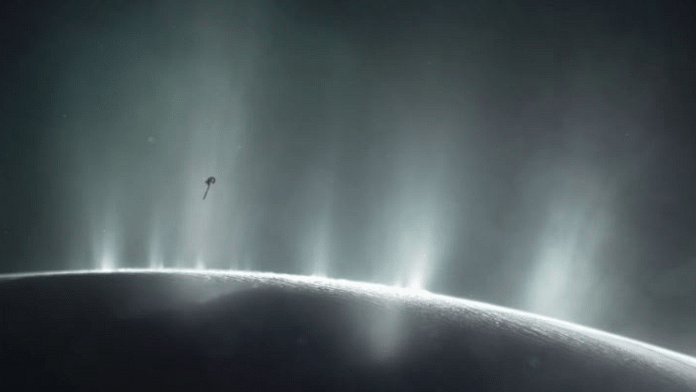Bengaluru: Scientists have found hydrogen cyanide — a key molecule in the creation of life — in the oceans of Saturn’s icy moon Enceladus, according to a new study based on data from the National Aeronautics and Space Administration’s (NASA) Cassini spacecraft.
The study, published this week in the journal Nature Astronomy, reveals that the oceans beneath the frozen surface of Enceladus may have more chemical energy than previously believed, which could support the formation and survival of complex organic compounds.
The moon’s oceans are known to be filled with organic molecules and compounds crucial for life as we understand it. The findings add a layer of evidence — strengthening the waters’ ability to hold life.
For the study, the researchers re-analysed data from Cassini, which orbited Saturn from 2004 to 2017, and sampled the plumes of gas, water, and ice that erupted from Enceladus’s surface.
They detected hydrogen cyanide along with methanol, ethane, and oxygen in the plumes of water vapour erupting from the surface of Enceladus, suggesting that the moon’s ocean chemistry is more diverse and dynamic than previously known.
“Our work provides further evidence that Enceladus is host to some of the most important molecules for both creating the building blocks of life, and for sustaining that life through metabolic reactions,” said lead author Jonah Peter of Harvard and NASA’s Jet Propulsion Laboratory.
Peter added: “Not only does Enceladus seem to meet the basic requirements for habitability, we now have an idea about how complex biomolecules could form there, and what sort of chemical pathways might be involved.”
The Cassini mission — a joint project between NASA, the European Space Agency and the Italian Space Agency — consisted of the Huygens lander, which landed on Saturn’s largest moon, Titan, also thought to be a candidate to host life.
Future studies of Enceladus are expected to yield more intricate details about the composition and present conditions of the moon.
White ball of ice
Enceladus, one of Saturn’s 146 moons, is an object of great interest to astronomers owing to its composition. It has a white, streaky surface made of water ice. Beneath this frozen crust lies a warmer, salty ocean that covers the whole moon.
The circular moon is just about 500 km wide, with a surface temperature of -200°C. But its interiors host several sources of energy and heat.
Enceladus is tugged and pulled in all directions by Saturn’s gravity and the gravity of other more massive moons, thus creating heat in its interior. Its rocky core may also be undergoing radioactive decay and chemical reactions that generate heat.
Moreover, it is also an active source of water volcanism, where giant plumes of water, ice, dust, and gases are ejected up into space like volcanic explosions. The material from the plumes replenishes one of the rings of Saturn as well, as the icy particles that make up the rings slowly drift inwards and get pulled into Saturn.
The presence of a global saltwater ocean with nutrients and a heat source suggests a suitable aquatic environment for life. However, no life has been found on Enceladus or anywhere else beyond Earth.
Hosting life with hydrogen cyanide
In June 2023, with the discovery of the presence of phosphates in the oceans, astronomers and astrobiologists confirmed that Enceladus has all the necessary chemical ingredients for life as we know it.
Apart from the plumes of water vapour, Enceladus is also believed to have hydrothermal vents and underwater hot water plumes, which resemble the primitive environments where life may have originated on Earth.
The new findings, which show the presence of hydrogen cyanide, also indicate that there might be more unidentified sources of energy within the moon — more powerful than those involved in the making of the previously detected biosignature molecule methane in Enceladus’s plumes.
More energy leads to the creation of more complex and versatile molecules, such as hydrogen cyanide, which is a key complex molecule involved in the beginning of the formation of life.
(Edited by Richa Mishra)
Also Read: Ice Age ‘writing system’ to ‘zombie worm’ — 10 biggest science headlines of 2023



